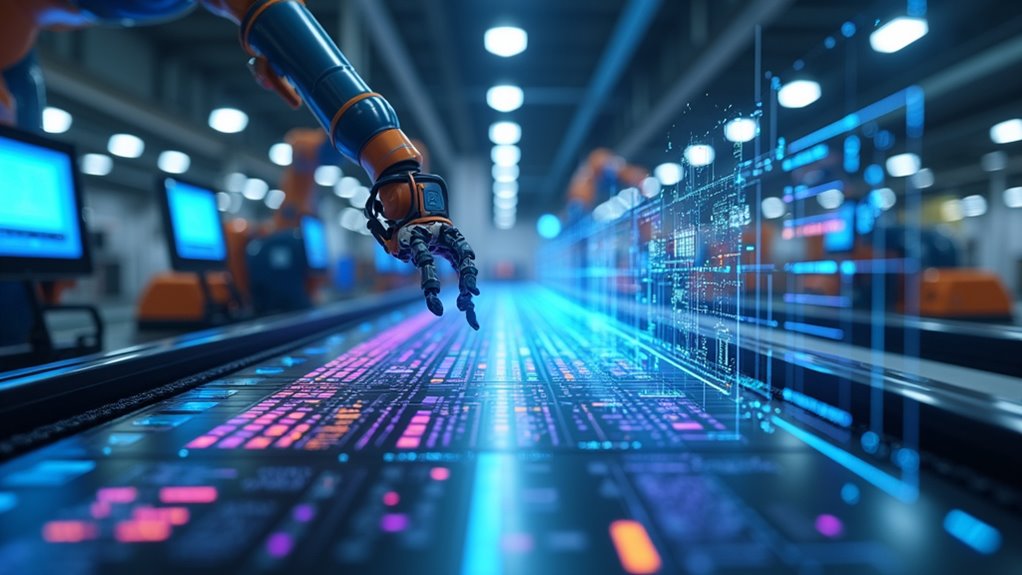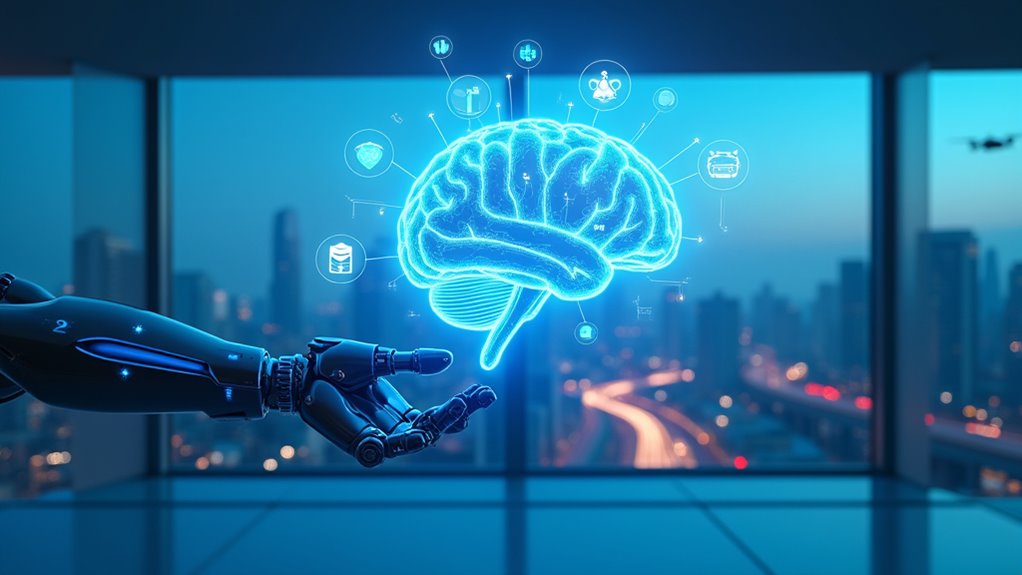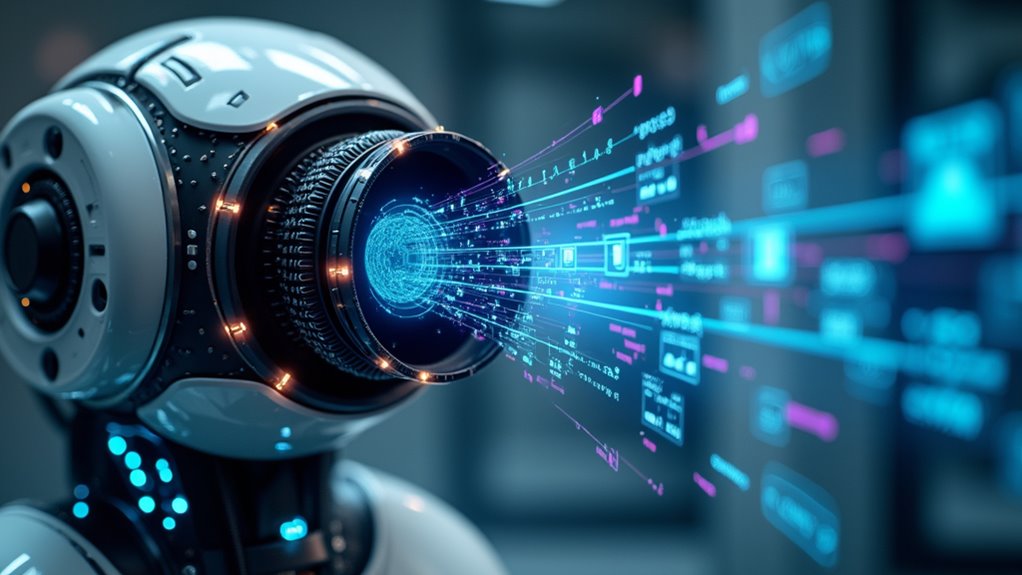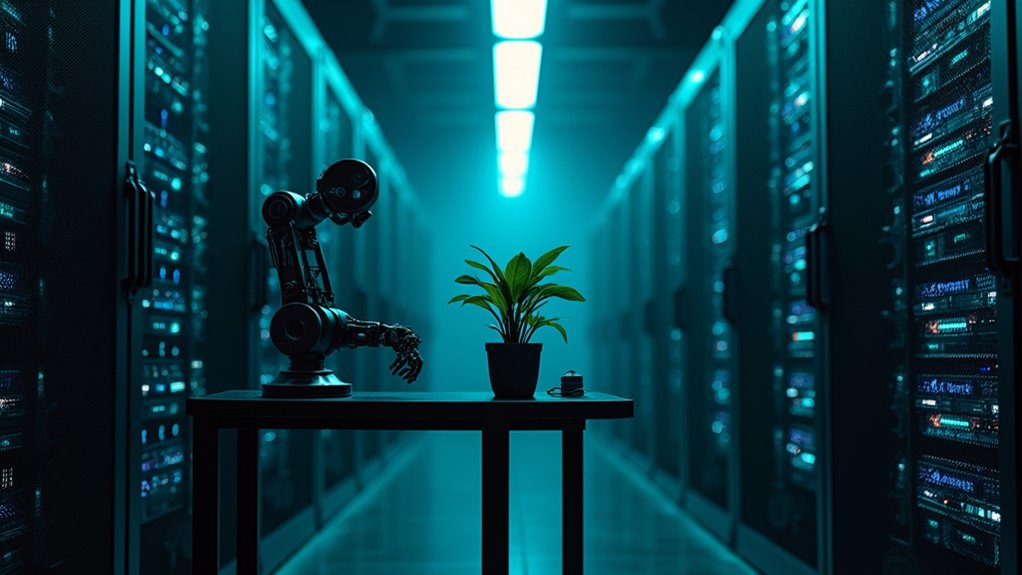AI’s industry transformation varies dramatically by sector. Aerospace leads with 85% adoption, while agriculture lags behind. Companies using AI report 35% higher revenue growth and nearly half see reduced costs. Healthcare spots disease patterns doctors miss, retailers anticipate customer needs, and manufacturing enhances quality control beyond human capabilities. AI isn’t replacing jobs—it’s evolving them from mundane tasks to strategic roles. Those resisting this technology wave may find themselves underwater while competitors surge ahead.

Artificial intelligence is sweeping through global industries like a digital tsunami, reshaping everything from aerospace to finance in its wake. The adoption patterns reveal a striking divide— aerospace leads with a whopping 85% implementation rate, while agriculture and construction struggle to keep pace.
These AI applications aren’t just fancy tech toys; they’re solving real industry challenges across sectors like healthcare, retail, and manufacturing with remarkable precision. Companies that once drowned in oceans of data now surf atop insights, thanks to machine learning algorithms that separate signals from noise. You’ve probably interacted with AI today without even realizing it!
AI isn’t tech for show—it’s extracting business insights from data chaos with surgical precision, affecting your life daily without fanfare.
The economic implications are staggering. By 2025, AI will pump an estimated $15.7 trillion into the global economy—that’s trillion with a T. Think of it as adding a whole new Germany to the world’s economic output.
The market itself will balloon to $826 billion by 2030, creating a gold rush for businesses smart enough to stake their claims early. Generative AI alone could add up to $4.4 trillion annually. That’s not pocket change!
Contrary to doomsday predictions, AI isn’t stealing jobs—it’s transforming them. About 41% of companies report job roles evolving rather than disappearing. In finance, where about 20% of tasks are currently automated, workers are shifting to higher-value activities. The robots aren’t taking over; they’re handling the boring stuff.
Operational efficiency gets supercharged when AI enters the picture. Nearly half of AI adopters report reduced costs while enjoying faster data analysis. The AI market already reached value of $327.5 billion in 2021, showing the significant investment companies are making in these technologies. Early adoption provides a competitive edge, with early adopters 35% more likely to see revenue growth compared to companies that delay AI investment.
Manufacturing facilities use AI for quality control that human eyes simply can’t match. Retail giants anticipate customer needs before shoppers even know what they want. Healthcare providers spot disease patterns invisible to even experienced doctors. Educational institutions are implementing adaptive learning platforms that personalize content based on student performance and learning styles.
The technology isn’t perfect—far from it—but its trajectory is clear. Industries that embrace AI now will thrive; those that resist will eventually wonder what hit them.
Frequently Asked Questions
How Quickly Will AI Eliminate Jobs Across Different Sectors?
Job displacement due to AI varies dramatically by sector.
Tech and manufacturing are experiencing rapid changes now, with thousands of jobs already eliminated.
Other sectors like healthcare show slower adaptation, with AI complementing rather than replacing workers.
The pace depends on sector-specific factors: automation potential, cost-benefit ratios, and regulatory landscapes.
By 2030, up to 14% of workers may need to change careers entirely.
One thing’s clear—the timeline isn’t uniform, but it’s definitely accelerating.
What Cybersecurity Risks Emerge With Widespread AI Adoption?
Widespread AI adoption introduces significant cybersecurity risks organizations can’t ignore.
AI vulnerabilities create new attack vectors for hackers, while vast data processing increases breach potential.
Privacy concerns multiply as AI systems collect and analyze unprecedented amounts of personal information.
Bad actors are leveraging these same technologies for ethical hacking gone wrong—crafting more convincing phishing attempts and generating malware at scale.
The security landscape is shifting rapidly, requiring new defensive strategies to match AI-powered threats.
Can Smaller Businesses Afford to Implement Effective AI Solutions?
Yes, smaller businesses can access effective AI solutions despite budget constraints. Affordable solutions exist through subscription-based tools starting around $1,800 annually and pre-trained models that avoid custom development costs.
Small business challenges include initial investment hurdles and expertise gaps, but cloud services and generative AI platforms offer accessible entry points. The key is starting small—perhaps with customer service chatbots or basic analytics—then scaling up as ROI becomes evident.
How Does AI Adoption Vary Between Developed and Developing Countries?
AI adoption varies dramatically across global economic lines. Developed nations enjoy robust AI infrastructure while developing countries face technological accessibility challenges that limit implementation.
The skill development gaps are stark – wealthy countries have talent pipelines while emerging economies struggle to retain AI experts.
However, developing regions actually show greater economic growth potential through AI, as they can leapfrog traditional development stages by implementing cutting-edge solutions without legacy system constraints.
What Regulations Are Being Developed to Govern Industrial AI Use?
Governments worldwide are racing to establish AI regulations for industrial use, though they’re moving at the speed of bureaucracy—shocking, right?
Industrial governance frameworks like the EU AI Act and U.S. Executive Order on AI aim to create enforceable compliance frameworks while balancing innovation.
Meanwhile, companies aren’t waiting; they’re developing ethical standards through voluntary self-regulation.
The challenge? Making these rules specific enough for manufacturing but flexible enough for finance.
Without legal teeth, though, many standards remain merely suggestions.








